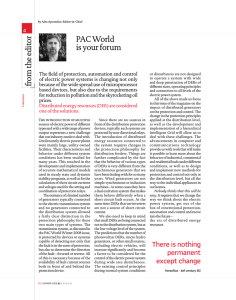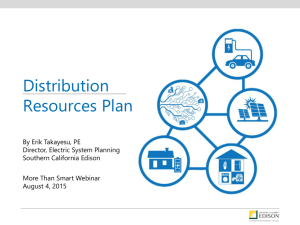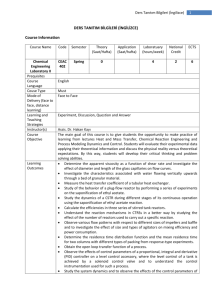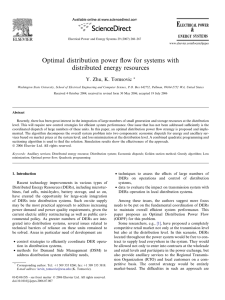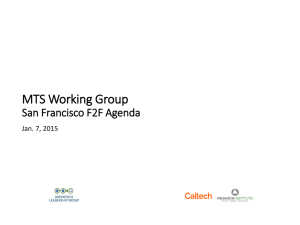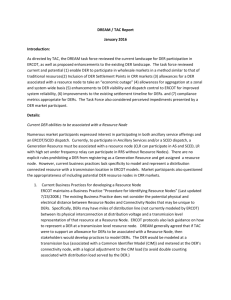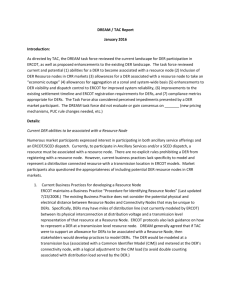cells can help to maintain the balance between generation and
advertisement
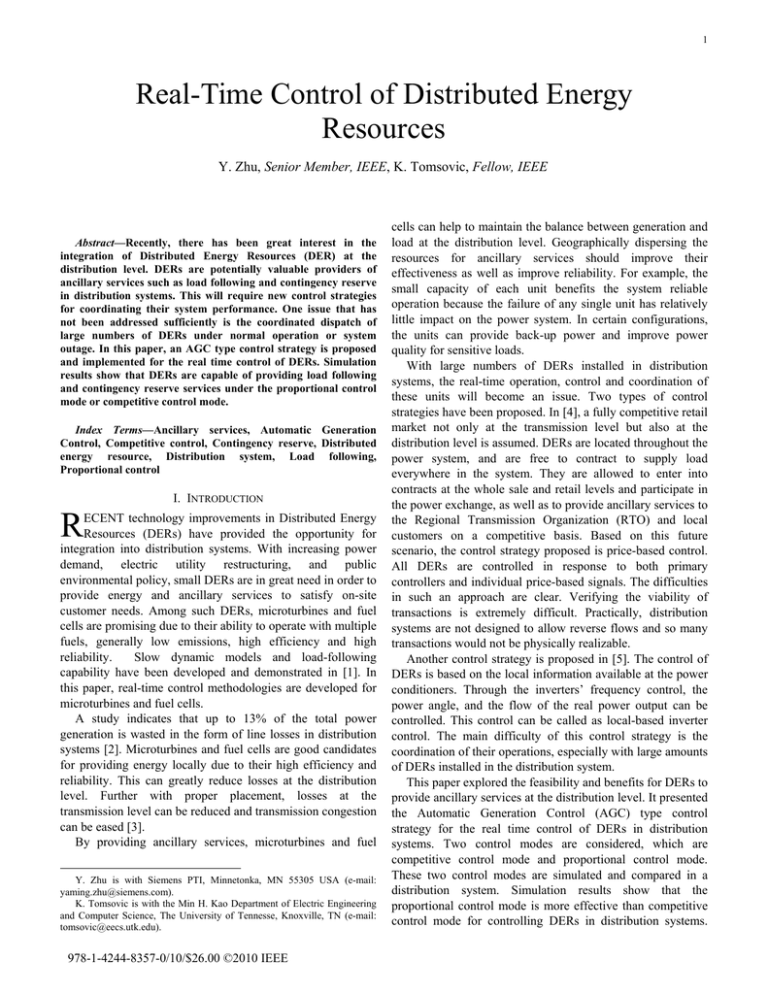
1 Real-Time Control of Distributed Energy Resources Y. Zhu, Senior Member, IEEE, K. Tomsovic, Fellow, IEEE Abstract—Recently, there has been great interest in the integration of Distributed Energy Resources (DER) at the distribution level. DERs are potentially valuable providers of ancillary services such as load following and contingency reserve in distribution systems. This will require new control strategies for coordinating their system performance. One issue that has not been addressed sufficiently is the coordinated dispatch of large numbers of DERs under normal operation or system outage. In this paper, an AGC type control strategy is proposed and implemented for the real time control of DERs. Simulation results show that DERs are capable of providing load following and contingency reserve services under the proportional control mode or competitive control mode. Index Terms—Ancillary services, Automatic Generation Control, Competitive control, Contingency reserve, Distributed energy resource, Distribution system, Load following, Proportional control R I. INTRODUCTION ECENT technology improvements in Distributed Energy Resources (DERs) have provided the opportunity for integration into distribution systems. With increasing power demand, electric utility restructuring, and public environmental policy, small DERs are in great need in order to provide energy and ancillary services to satisfy on-site customer needs. Among such DERs, microturbines and fuel cells are promising due to their ability to operate with multiple fuels, generally low emissions, high efficiency and high reliability. Slow dynamic models and load-following capability have been developed and demonstrated in [1]. In this paper, real-time control methodologies are developed for microturbines and fuel cells. A study indicates that up to 13% of the total power generation is wasted in the form of line losses in distribution systems [2]. Microturbines and fuel cells are good candidates for providing energy locally due to their high efficiency and reliability. This can greatly reduce losses at the distribution level. Further with proper placement, losses at the transmission level can be reduced and transmission congestion can be eased [3]. By providing ancillary services, microturbines and fuel Y. Zhu is with Siemens PTI, Minnetonka, MN 55305 USA (e-mail: yaming.zhu@siemens.com). K. Tomsovic is with the Min H. Kao Department of Electric Engineering and Computer Science, The University of Tennesse, Knoxville, TN (e-mail: tomsovic@eecs.utk.edu). 978-1-4244-8357-0/10/$26.00 ©2010 IEEE cells can help to maintain the balance between generation and load at the distribution level. Geographically dispersing the resources for ancillary services should improve their effectiveness as well as improve reliability. For example, the small capacity of each unit benefits the system reliable operation because the failure of any single unit has relatively little impact on the power system. In certain configurations, the units can provide back-up power and improve power quality for sensitive loads. With large numbers of DERs installed in distribution systems, the real-time operation, control and coordination of these units will become an issue. Two types of control strategies have been proposed. In [4], a fully competitive retail market not only at the transmission level but also at the distribution level is assumed. DERs are located throughout the power system, and are free to contract to supply load everywhere in the system. They are allowed to enter into contracts at the whole sale and retail levels and participate in the power exchange, as well as to provide ancillary services to the Regional Transmission Organization (RTO) and local customers on a competitive basis. Based on this future scenario, the control strategy proposed is price-based control. All DERs are controlled in response to both primary controllers and individual price-based signals. The difficulties in such an approach are clear. Verifying the viability of transactions is extremely difficult. Practically, distribution systems are not designed to allow reverse flows and so many transactions would not be physically realizable. Another control strategy is proposed in [5]. The control of DERs is based on the local information available at the power conditioners. Through the inverters’ frequency control, the power angle, and the flow of the real power output can be controlled. This control can be called as local-based inverter control. The main difficulty of this control strategy is the coordination of their operations, especially with large amounts of DERs installed in the distribution system. This paper explored the feasibility and benefits for DERs to provide ancillary services at the distribution level. It presented the Automatic Generation Control (AGC) type control strategy for the real time control of DERs in distribution systems. Two control modes are considered, which are competitive control mode and proportional control mode. These two control modes are simulated and compared in a distribution system. Simulation results show that the proportional control mode is more effective than competitive control mode for controlling DERs in distribution systems. 2 With the AGC type control strategy, the reliability of distribution system is satisfied and the impact of DERs on transmission system is limited. The organization of this paper is as follows. Section II introduces the feasibility and benefits of providing ancillary services from DERs at the distribution level. The AGC type control strategy with the consideration of two control modes (competitive control mode and proportional control mode) are presented in Section ΙΙΙ. Simulation results for load following and contingency reserve performance from DERs are compared between two control modes in Section IV. Conclusions are given in Section V. II. DERS AS PROVIDERS OF ANCILLARY SERVICES The Federal Energy Regulatory Commission (FERC) defines ancillary services in [9] as those “necessary to support the transmission of electric power from seller to purchaser given the obligations of control areas and transmitting utilities within those control areas to maintain reliable operations of the interconnected transmission system.” Ancillary services have different types: regulation, load following, contingency reserve, frequency response, reactive power supply from generation sources, system black start capability, etc. Different types of ancillary services are quite different in terms of time frame, characteristic features, and operation. Frequency response, regulation, load following, and contingency reserve are all real power ancillary services and mainly used to maintain the desired level of reliability in system’s normal operation and outages. Although these services can be acquired from a competitive ancillary service markets, there are several reasons for local procurement, including: • Transmission congestion may prevent the use of remote sources. • Local services are generally more effective for the reliability of specific region, especially for voltage control. • Providing ancillary services from several local small resources is more reliable than a single, or a few, large central resource(s). DERs are potentially valuable providers of regulation, load following, and contingency reserve for the local control area. With the advantages of small capacity, when sited locally within the distribution system, they may contribute significantly to distribution system reliability. Reactive power supply from generation sources and system black start capability are highly location dependent. In a distribution system, these two services could be totally provided from DERs. In [1], it is demonstrated that DERs such as microturbines and fuel cells are capable of providing load following service in the distribution system. By providing reactive power support from DERs and optimizing the shunt capacitors’ switching, the real power losses in the distribution feeder can be minimized [7]. With more and more DERs providing energy and ancillary services in the distribution systems, it becomes imprtant to develop control strategies to efficiently coordinate DERs’ operation in distribution systems. III. AGC TYPE CONTROL STRATEGY Automatic Generation Control (AGC) is used for maintaining system frequency and controlling tie-line flows to the scheduled values [6]. With the consideration of AGC type control strategy for the real-time operation of DERs in a distribution system, the following assumptions are made: • The distribution system has a strong connection with the transmission system. Most of power is delivered from the transmission system to the distribution feeder. In addition, DERs provide ancillary services and small amount of energy in the distribution system; • The real-time operation of DERs focuses on slow dynamics, such as providing ancillary-services. Fast dynamics are not considered; • Because the feeder load is small relative to overall power system, the frequency deviation is assumed zero. • Bilateral contracts to provide ancillary services among DERs on a given feeder are not allowed. That is, the ancillary services must be coordinated at the substation or transmission level; • There is a simple communication system in the distribution system. The communication network is simply modeled as a fixed time delay of 0.5 s and lost messages or other failures are not considered. The feeder can measure the power supply to the substation, conceptually a “tie-line” flow, and then send related information to all DERs. In this way, the DERs work together to provide ancillary services; • For ancillary services acquired from the markets, the feeder is assumed to be able to obtain the required quantity at the market rate from the transmission system as necessary; With this AGC type control, the tie-line flow between the feeder and the connected transmission system is maintained at the desired value. The DERs are coordinated to provide the required ancillary services. Balance between generation and load in the distribution system is maintained during normal operation and outages if possible. Two modes of real-time control are considered. The first is called competitive control mode, where the feeder controller broadcasts the information of tie-line mismatch and the type of required ancillary service to all DERs. The DERs which have been dispatched compete to supply as much of the service as possible in order to receive payment. Notice this supply is also self-limited by DERs to be within their dispatched quantities. The competitive control mode allows relatively independent operation of DERs. The second mode is called proportional control mode. The feeder controller sends the tie-line flow mismatch individually to each DER according to the percentage the unit has agreed to 3 supply. This means that the DERs need to supply the ancillary service proportionally to their dispatched quantity. It is similar with the traditional central control mode and requires the substation to have complete information about the connected DERs. IV. SIMULATION RESULTS A. Example Distribution System The proposed AGC type control strategy for DERs is implemented for the system in Fig. 1, which is based on a distribution feeder in the Kumamoto area of Japan [7]. The network parameters can be found in [8]. The distribution system base value is 10 MVA with a line voltage of 6.6 kV. There are six DERs integrated in the distribution system, each consists of several Solid Oxide Fuel Cell (SOFC) stacks or microturbines which are modeled as described in [1]. These DERs are classified in Table I. The total load in this distribution system is Pload =18.9 from DERs. A total load increase of 3% is simulated. Loadfollowing service is provided by the DERs installed in the example distribution system. It is assumed that there is no load-following service acquired from the transmission system here, all is selfprovided from the DER units. Simulation results under the competitive and proportional control modes for a 3% total step load increase are shown in Fig. 2 and Fig. 3, respectively. From the simulations, the following conclusions can be drawn: • Under both the competitive and proportional control modes, DERs are capable of providing effective loadfollowing service; • The maximum deviation and the time to return to scheduled tie line flow is significantly better in the proportional mode. Thus, assuming the DERs can be dispatched fairly using the centralized proportional approach, this method provides better performance. MW, Qload =1.3 Mvar. 1.1 G 4 1 2 3 5 4 6 1 SS G 5 12 13 14 Normalized Real Power G2 15 G14 7 8 9 10 11 0.9 Load Tie Line Flow G2 Output G7 Output 0.8 0.7 0.6 G11 0.5 G 7 0.4 Fig. 1. Kumamoto 15-bus distribution system diagram. 0 50 TABLE I CLASSIFICATION OF DISTRIBUTED ENERGY RESOURCES Type G2 3-SOFC 900 G4 2-SOFC 600 G11 2-SOFC 600 G5 3-microturbine 750 G7 4-microturbine 1000 G14 3-microturbine 750 Rated Power Prate (kW) B. Load Following Performance Load following maintains interconnection frequency, and keeps generation and load balance within the control area but on scale of several minutes to hourly. In so doing, load following resources should follow the hour-to-hour and daily changes in customer loads. Load variations in the example distribution system are considered for simulating the load following performance 150 Time (s) 200 250 300 (a) load following performance 1.04 Load Tie Line Flow 1.03 Normalized Real Power DERs 100 1.02 1.01 1 0.99 0.98 0 50 100 150 Time (s) 200 250 (b) tie-line flow variation Fig. 2. Load following in competitive control mode 300 4 1.1 • Given a strong and reliable inter-tie with the transmission system, sudden large and unanticipated disturbances can be managed effectively with the combined supply of contingency reserve from transmission system and local DERs. This provides an increased security for the distribution system without excessively taxing the distribution system. • Similar to the load following performance, the proportional control approach is more effective than that of competitive control. Normalized Real Power 1 0.9 Load Tie Line Flow G2 Output G7 Output 0.8 0.7 0.6 0.5 1.1 0.4 0 50 100 150 Time (s) 1 Normalized Real Power (a) load-following performance 1.04 Load Tie Line Flow Normalized Real Power 1.03 Tie Line Flow G2 Output G7 Output 0.9 0.8 0.7 0.6 1.02 0.5 1.01 0.4 0 10 20 30 1 50 60 70 80 70 80 (a) contingency-reserve performance 0.99 0.98 40 Time (s) 1.025 0 50 100 150 Time (s) (b) tie-line flow variation Fig. 3. Load following in proportional control mode C. Contingency Reserve Performance Contingency reserve consists of spinning reserve and supplemental reserve. The differences between them are: one, spinning reserve must be synchronized to the grid and be ready to respond immediately to an outage, and two, supplemental reserve is far cheaper than spinning reserve, primarily because it involves very little operating cost and no opportunity cost. Contingency reserve should be distributed among as many units as possible in the control area for better reliability. For consideration of outages, the plant G5 separates from the system. Contingency reserve service is supplied from both the transmission system and local DER units. The transmission system can supply contingency reserve up to 200 kW at the rate of 40 kW/s during an outage of a generator. The needed reserve is assumed to be determined by the substation controller. Here again, the simulations compare the competitive and proportional control approaches, which are given in Fig. 4 and Fig 5, respectively. From these simulations, the followings are observed: Normalized Tie Line Flow 1.02 1.015 1.01 1.005 1 0 10 20 30 40 Time (s) 50 60 (b) tie-line flow variation Fig. 4. Contingency reserve in competitive control mode 5 Proportional control mode and competitive control mode are two control modes to be considered and compared. The competitive control mode allows relatively independent operation of DERs. With the proportional control mode, it is more effective to provide load following and contingency reserve services from DERs. Both control modes with AGC type control strategy are demonstrated to be capable for the coordination of DERs for a moderate size distribution system. 1.1 Normalized Real Power 1 0.9 0.8 Tie Line Flow G2 Output G7 Output 0.7 VI. REFERENCES 0.6 [1] 0.5 [2] 0.4 0 10 20 30 40 Time (s) 50 60 70 80 [3] (a) contingency-reserve performance [4] Normalized Tie Line Flow 1.015 [5] [6] 1.01 [7] 1.005 [8] [9] 1 0 10 20 30 40 Time (s) 50 60 70 80 (b) “tie-line” flow variation Fig. 5. Contingency reserve in proportional control mode V. CONCLUSIONS Distributed Energy Resources are potentially valuable providers of ancillary services such as load following and contingency reserve in distribution systems. As greater numbers of DERs are incorporated into the distribution systems, there will come to the point where the DERs must be dispatched and their operation carefully coordinated. The radial structure of the distribution system and the small size of the DERs suggest that this coordination is best performed at the substation level. To coordinate through central markets it may need excessive complexity for those markets with little effective increase in market competitiveness. AGC type control strategy proposed in this paper is to control and coordinate the operation of DERs installed in the distribution system, under the situations of load variations or system outage in the distribution level. With the AGC type control, the tie-line flow between the feeder and the connected transmission system is maintained at the desired value. The DERs are coordinated to provide the required ancillary services during normal operation and outages if possible. Y. Zhu and K. Tomsovic, “Development of models for analyzing the load following performance of microturbines and fuel cells,” Journal of Electric Power Systems Research, Vol. 62, Issue 1, May 2002, pp. 1-11. H. Salehfar and A. Wehbe, “Direct control of residential water heater loads to reduce power system distribution losses,” Proceedings of the IEEE/PES 2001Winter Meeting, Columbus, Ohio, USA, Jan. 2001. T. Griffin, K. Tomsovic, D. Secrest, and A. Law, “Placement of dispersed generations systems for reduced losses,” Proceedings of the 33rd Hawaii International Conference on Systems Sciences, Maui, Hawaii, Jan. 2000. Judith B. Cardell, “Integrating small scale distributed generation into a deregulated market: control strategies and price feedback,” Ph.D Dissertation, Massachusetts Institute of Technology, Sep. 1997. R. H. Lasseter, “Control of distributed resources,” Proceedings of the 1998 International Conference on Bulk Power Systems Dynamics and Control ΙV – Restructuring, Santorini, Greece, Aug. 1998, pp. 323-330. A. J. Wood and B. F. Wollenberg, Power Generation, Operation, and Control, 2nd ed., New York: John Wiley & Sons, 1996, pp. 328-356. Y. Zhu and K. Tomsovic, "Optimal distribution power flow for systems with distributed energy resources," International Journal of Electric Power and Energy Systems, Vol. 29, Issue 3, March 2007, pp. 260–267. S. Li, K. Tomsovic, and T. Hiyama, "Load Following Functions Using Distributed Energy Resources," Proceedings of the 2000 IEEE PES Summer Meeting , Seattle, July 2000, pp. 1756-1761 Federal Energy Regulatory Commission, “Notice of Proposed Rulemaking: Docket No. RM95-8-000,” Mar. 1995. VII. BIOGRAPHIES Y. Zhu (SM’2003) received the B.S. from Tsinghua University, P.R. China, in 1989, the M.S. from the Graduate School of Nanjing Automation Research Institute, P.R. China, in 1992, and the Ph.D. degree from Washington State University, Pullman, in 2002, all in Electrical Engineering. He is currently with the consulting department at Siemens PTI. He is involved in transmission planning studies, generator interconnection studies, transmission service request studies, and dynamic model verification. He was with Midwest ISO from 2002 to 2008 as a senior planning engineer, and with Nanjing Automation Research Institute (NARI), China as an R & D project manager responsible for development of various power system automation products from 1992-1998. K. Tomsovic (F’2007) received the B.S. degree in electrical engineering from Michigan Technological University, Houghton, in 1982 and the M.S. and Ph.D. degrees in electrical engineering from the University of Washington, Seattle, in 1984 and 1987, respectively. Currently, he is Head and CTI Professor of the Department of Electrical Engineering and Computer Science at University of Tennessee, Knoxville. Visiting University positions have included Boston University, Boston, MA; National Cheng Kung University, Tainan, R.O.C.; National Sun Yat-Sen University, Kaohsiung, Taiwan, R.O.C.; and the Royal Institute of Technology, Stockholm, Sweden. He was on the faculty of Washington State University from 1992-2008. He held the Advanced Technology for Electrical Energy Chair at Kumamoto University, Kumamoto, Japan, from 1999 6 to 2000 and was an NSF program director in the ECS division from 2004 to 2006.
